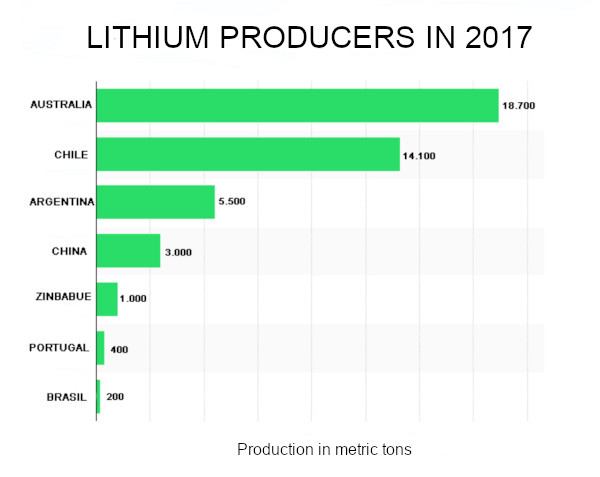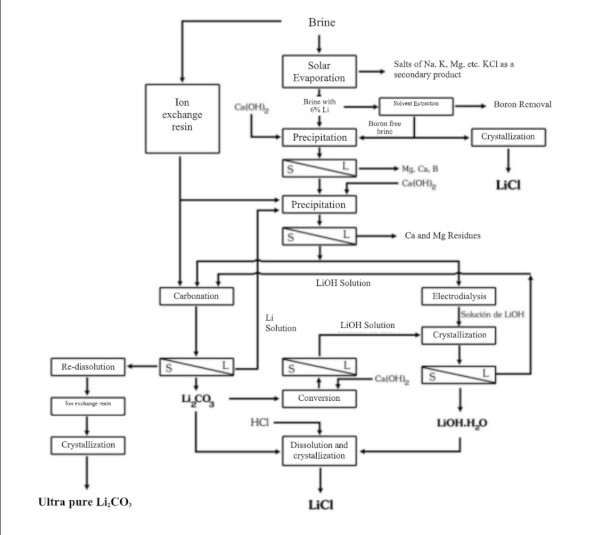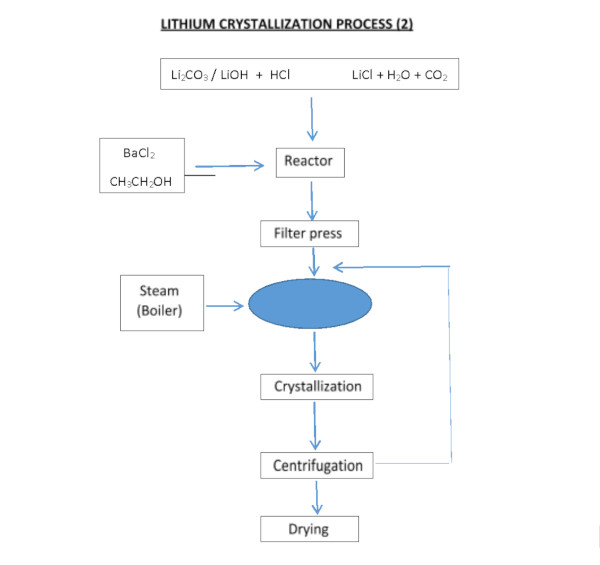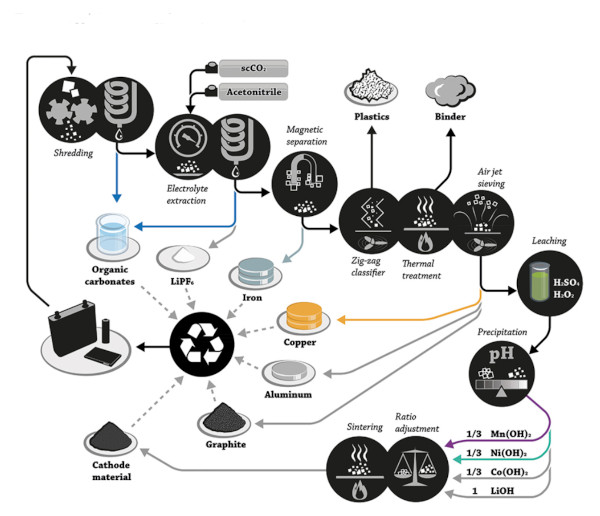Sections
- Basic characteristics of lithium
- Scope of application
- Recycling electronics
- Extraction and obtaining lithium
- Recycling batteries and the recovery of lithium
- Conclusions
Basic characteristics of lithium
The name of the metal lithium (from the Greek λίθoς -ου, "stone"), comes from the fact that it was first found in a mineral, while the rest of the alkali minerals were discovered in plant materials. It was Johann Arfvedson in 1817, who found the new element spodumene and lepidolite from a petalite mine, LiAl(Si2O5)2, on the island of la Utö (Sweden).
In 1818, C.G. Gmelin was the first to observe that lithium salts turn a flame into a bright red color. Both tried unsuccessfully to isolate the element from their salts, which W.T. Brande and Sir Humphrey Davy finally managed to do using electrolysis of lithium oxide.
In 1923 the German company Metallgesellschaft AG began producing it using electrolysis of molten lithium chloride and potassium chloride.
Lithium (Li) is the lightest metal, its density is half that of water. Like other alkali metals it is monovalent and very reactive, although less so than sodium.
Therefore, it is not found freely in nature. It is a moderately abundant element. It is present in the Earth's crust at 65 ppm, which places it below Ni, Cu and W and above Cr and Sn.
Next to H and He, lithium is one of the only elements that were first produced during the Big Bang. All others were created during nuclear fusion when the very first stars were formed or during supernova explosions.
It has the following basic physical chemical characteristics:
Density : 535 Kg/m 3
Mohs hardness : 0.6
Appearance : Solid white silver , grey
Atomic mass : 6.941
Atomic radius : 167 pm
Oxidation state : Strong base
Crystal structure : Cubic body-centered
Melting point : 453.69 K
Boiling point : 1615 K
Specific heat : 3582J/(Kg.K)
Scope of application
Lithium is known as ‘white oil’ because of the leading role it plays and predictably will play in the energy landscape in the future. Its properties make lithium ions the perfect ingredient for manufacturing batteries.
Due to its high specific heat, it is used in heat transfer applications, and due to its high electrochemical potential, it is a suitable anode for electric car batteries, smartphones and some electronic devices.
The following uses are also given, although their consumption is relatively small in relation to the aforementioned batteries:
- Lithium salts, particularly lithium carbonate (Li2CO3) and lithium citrate, are used in the treatment of mania and bipolar depression, although lately, its use has been extended to unipolar depression. It is a mood stabilizer. Its effects are thought to be based on its active effects on human serotonin function. In addition, it is found dissolved in blood plasma and/or in erythrocytes.
- Chloride and lithium bromide have high hygroscopicity, so they make excellent drying agents. The second is used in heat absorption pumps, among othercompounds such as lithium nitrate.
- Lithium stearate is a general lubricant used in high temperature applications.
- Lithium is an agent used in the synthesis of organic compounds.
- Lithium hydroxide is used in spacecraft and submarines for air purification by extracting carbon dioxide.
- It is a common part of the alloys of aluminum, cadmium, copper and manganese used in aeronautical industry, and has been used successfully in the manufacture of ceramics and lenses, such as the 5.08 m diameter telescope on Monte Palomar.
- It also has nuclear applications. Lithium has two stable isotopes: Li-6 and Li-7,the second being the most abundant (92.5%).
Each year 800,000 tones of car batteries, 190,000 tones of industrial batteries and 160,000 tones of batteries from electronic consumer goods enter the European Union markets. Inside their make up, these batteries contain lithium and other valuable metals metals such as cobalt, copper, etc.
On a global scale, it is estimated that the market for lithium ion batteries will generate around 46.21 billion dollars of income in 2022. Due to the growing supply-demand tension in the market, lithium prices increased by 47% in 2016, and demand is estimated to increase by 64% by 2020.
There are problems from the environmental effects when mining this mineral, such as water contamination, impacts on the countryside, impacts on flora and fauna and generation of solid and chemical waste.
Argentina is very concerned over these questions, as the authorities have confirmed that the country will triple lithium production in 2019. It is expected that by 2025, the production of lithium will be around between 400,000 and 500,000 tones.
Recycling electronics
The processing and recycling of the waste that comes from electrical and electronic devices, such as computers, televisions, fridges, and mobile phones is today more important than ever due to the rapid rise in consumption of these products.
Europe was the second region in the world that produced the most electronic waste in 2016 with 12.3 million tones (MT), after Asia which generated 18.2 MT. Despite all the current legislation, reports show that only 8.9 MT of electronic waste is gathered and recycled worldwide. That is equivalent to 20% of all the electronic waste generated.
According to reliable sources, 80% of the “tech rubbish” generated by the first world is sent to Africa, both to supply the trade for these products with second-hand units, often obsolete and of very short life, and to nourish illegal recycling chains.
In fact, metals such as vanadium, cobalt, arsenic, aluminum, chrome, lead…etc, have been found in blood samples that were analyzed from African migrants that surpassed the values of those obtained from people from more technologically advanced countries, such as Japan or the U.S.
The authors highlight another fact: Africa may be behind the rest of the world on landlines, but mobile use has skyrocketed in its countries in recent years, both in cities and rural areas and 97% of the mobile phones are second-hand.
Therefore, improved monitoring of these types of pollutants is recommended, because some of these elements carry an enormous health risk, and because it is well known that pollution does not respect borders.
So, the improper handling of this technological waste in those countries can produce a general increase in worldwide pollution.
When recycling Li batteries, the lithium they contain is discarded. This may seem an incongruity, but economically it is not, because the price of lithium is around 6 euros per kilo, low enough that there is no private endeavor in favor of recycling.
Currently, when we send our lithium batteries for recycling, the metals that are extracted from them are the most valuable, such as cobalt. Cobalt is used in lithium-ion batteries, from which it is then extracted in the form of cobalt oxide and lithium, with a price of 19 euros per kilo, more than three times the price on the lithium market.
Due to the low price of lithium, which is expected to remain stable thanks to new deposits found in Bolivia, its recovery of used batteries does not imply any business incentive, leaving it as a simple filler for concrete, thus preventing its future recovery and utilization.
However, this entails risks, since batteries contain acids and alkalis that act as electrolytes during their operation. No one can assure that there is no internal leaching inside the batteries (dissolution), once buried and that it may corrode the concrete since this material may be exposed to leaks and breakage by tremors or earthquakes, which could cause the material to reach the ground and to the underground and aquifer layers.
Extraction and obtaining lithium
Extraction from minerals
There are several different mining procedures. Australia, the biggest global producer of lithium, obtains it through conventional mining of minerals such as spodumene from Greenbush, but it's an expensive and dirty process.
Chile, Argentina and China, on the other hand, use a slow process of evaporation of saline water. It is extracted from brines where it exists in natural salt flats such as in the Salar de Atacama in Chile or in the Hombre Muerto and others in Argentina, or from deposits.
Much of the world's lithium production comes from these brines, whose production cost is much lower than from mineral deposits (according to John McNulty: 1,500-2300 $/Tm and 4,200-4.500$/Tm, respectively).
Bolivia's lithium reserves or resources are in brines, which have an approximate density of 1,200 grams per liter (g/l), so a lithium concentration of 0.1% by weight will be equivalent to 1,000 parts per million (ppm) and 1.2g/l.
The extraction of lithium brines is carried out by pumping and its concentration by means of adsorption using a selective adsorbent, or by evaporation in shallow pools built for this purpose.
The evaporation, in addition to raising the concentration of the salts, causes some of these to be precipitated when saturated. Adsorption has the advantages that it is not influenced by the composition of saltwater (brines with low concentrations of lithium can be treated just like experiments with seawater), nor by the weather conditions of the place and not much waste is generated.
The disadvantages are that reagents are necessary; the adsorption equipment is expensive and complicated and the cost of the adsorbent is high. The advantages of natural evaporation are basically that no energy is consumed nor many chemical reagents are used, while its disadvantages are the need to simultaneously use another method of separation, the accumulation of waste and the dependence on the local weather conditions (evaporation rate and rainfall).
The world's largest production of lithium from brines is obtained from the Salar de Atacama in Chile, where the method of evaporation is used and from which the data and many operating factors allow comparison with those at the Salar de Uyuni in Bolivia.
The brines of Atacama are richer than those of Uyuni in lithium (also in potassium and boron), so the Mg/Li ratio, harmful to the concentration of lithium is 6/1 and 19/1 respectively.
While evaporation and rainfall are 3,200 mm/year and 10-15 mm/year in Atacama, in Uyuni they are 1,500 mm/year and 200-500 mm/year, that is to say that in Uyuni the evaporation is lower and the much higher rainfall, which slows evaporation quite a bit.
In Atacama, the evaporation process that concentrates lithium from 0.15% to 6% (40 times) lasts from 12 to 18 months. It is expected that this process will last much longer in Uyuni.
The laboratory study "Chemical treatment of brines from the Salar de Uyuni-Potosí" carried out in 1987 in France by the UMSA-ORSTOM (French Institute for Scientific Research for Development), simulating the conditions of evaporation pools in 5 containers, established that sodium chloride (NaCl) first precipitates and then potassium chloride (KCl) almost immediately.
Since magnesium chloride (MgCl2) cannot be separated with evaporation, which complicates the process, it is precipitated as magnesium hydroxide (Mg(OH)2) by adding lime.
The process of obtaining lithium chloride, from carbonate or lithium hydroxide, can be achieved by reacting with hydrochloric acid:
Li2CO3 + 2HCl === 2LiCl + H20 + C02
LiOH·H2O + HCl === LiCl + 2H2O
Precipitation and refining of lithium carbonate (LC)
The LC obtained by any method must be purified, dried and crystallized. Despite the high lithium content in the Salar de Atacama and the experience in obtaining it, it is shown that its recovery is 42%.
The LC to be used in the manufacture of batteries for electric vehicles must have a purity of at least 99.95%, so the LC obtained by precipitation must be refined through various reactions and recrystallization stages, in some cases by an ion exchange resin.
Because the refining process has a high cost and its recovery is lower after each stage (in the refining stage it is estimated at approximately 70%), the higher the purity the LC gets, its price increases by much greater proportion.
Recycling batteries and the recovery of lithium
Aware of the need to recycle lithium from used batteries and considering its future scarcity and increasing cost, various processes have been studied which are set out below:
Physical – Chemical Process
The recovery of the materials that make up the lithium-ion batteries is done through the Leaching process. That is, through the use of acids to dissolve the components once the device has been taken apart.
The whole process must follow a series of steps, starting with the collection of batteries, classification and discharge of electricity. Then, the separation of its components is carried out, until the anode and the cathode (parts that allow the electrochemical reaction) are completely separated.
In this way each part is handled separately to recover the raw materials of the battery.
Another system presents an alternative for the recovery of lithium, cobalt, manganese and nickel from used batteries of mobile phones and computers.
The process begins with the manual disassembly of these to separate the residue of interest, then a reduction in size is carried out and between 560 and 800 μm is reached from the waste of the devices, respectively.
Aluminum and copper are leached with ammonium hydroxide to eliminate interference reactions at later stages.
The filtered wash from the previous stage is leached with sulfuric acid, and maximum recoveries of 96.0 and 99.9% of lithium, cobalt, manganese, nickel are obtained, with concentrations of 3.0 and 4.0 M, in each residue type.
The leached acid cocktail is neutralized with sodium hydroxide, sodium bicarbonate is added and manganese carbonate, cobalt hydroxide and lithium bicarbonate are precipitated, with the respective necessary conditions.
Then Evapo-crystallization of the precipitated products is carried out and recoveries greater than 96.0% are achieved in each metal.
Lithium Carbonate (Li2CO3) is the most commonly used lithium compound; One gram of lithium equals 5.32 grams of lithium carbonate (CL).
Lithium electrochemical recovery
Recently, Argentine researcher Ernesto Calvo has proposed the implementation of an innovative lithium extraction technology on a large scale, without generating polluting waste. To do this, the brine is extracted by means of a pumping system in order to place a reactor with two electrodes.
These selectively trap, on the one hand, lithium ions, and on the other, brine chloride, to be returned to the salt flat. Subsequently, the electrical polarity of the reactor is reversed and the reverse process is done, that is, the brine is removed and a recovery solution is added that concentrates the lithium chloride.
Solar energy is used for this process and the lithium chloride extracted from the brine forms a kind of lithium battery for storing intermittent renewable energy.
Reverse Osmosis membranes capable of separating lithium
Recently, a new technology has been developed that will allow lithium to be taken out of sea water and to do so efficiently, also producing potable water in the process.
As we know, seawater is a complex cocktail of useful minerals, but it is difficult to separate the ones we need, such as lithium. A team of scientists from Australia and the United States have developed a new water desalination technique that can not only make seawater drinkable, but also recovers the lithium present in it.
The key to the process is metal-organic structures (MOF), which have the largest internal surface area of any known material. A single gram could theoretically cover a soccer field, and it is this intricate internal structure that makes them perfect for capturing, storing and releasing molecules.
Currently, reverse osmosis membranes are the most commonly used technology for water filtration, and they work in rather simple way.
The pores of the membrane are large enough for water molecules to pass through, but they are too small for most contaminants. The problem is that, to work, these systems require pumping water at a relatively high pressure.
MOF membranes, on the other hand, can be more selective and efficient.
Researchers at Monash University, the Commonwealth Scientific and Industrial Research Organization and the University of Texas have developed such a membrane.
The design was inspired by the "ionic selectivity" of biological cell membranes, allowing the MOF material to dehydrate specific ions as they pass through. Better yet, these filters do not require water to form, which also saves energy.
"We can use our findings to address the challenges of water desalination," says Huanting Wang, author of the new study. Instead of relying on expensive processes and currently high energy consumption, this research opens the door to remove salt ions from water in a much more efficient way in terms of energy and environmental sustainability.
These lithium ions are abundant in seawater (approx. 0.17 ppm), so the development of this technology could have great repercussions for the mining industry that currently uses chemical and inefficient treatments to extract lithium from rocks and brines.
The global demand for lithium required for sectors such as the electric car industry is increasingly high, so these membranes are positioned as an efficient alternative to extract the lithium itself from seawater, which is an abundant and easily accessible resource.
Thus, its exploitation should also be economic. In this application we can think of a reverse osmosis of the closed type in order to maximize the concentration of lithium and thus reduce the size and cost of the subsequent necessary Evapo – Crystallization system.
Selective evaporative recovery of lithium (LiOH)
The selective recovery of lithium from brines with a content of less than 1% in the presence of high concentrations of other alkaline and alkaline earth ions is an industrial objective.
Evaporative processes are based on differential solubility of lithium salts in concentrated brine solutions which is called fractional recrystallization. Alternatively, selective chemical and electrochemical processes have been designed for the recovery of high purity lithium chloride, lithium hydroxide or lithium carbonate that seek to reduce process times and reduce environmental impact due to water loss and the formation of environmentally harmful waste.
Recently, a rapid method based on the precipitation of low-soluble lithium phosphate, Li3PO4 (0.39g/l) has been proposed for treatment of brines with phosphoric acid:
3Li3PO4 + 5Ca(OH)2 → Ca5(PO4)3.OH + 9LiOH
Then the insoluble lithium phosphate is treated with lime to form very insoluble hydroxyapatite and recover soluble lithium hydroxide.
Processes of extracting lithium from Argentine salt mines. In this process phosphoric acid is recovered by treatment of hydroxyapatite with sulfuric acid, with formation of hydrated calcium sulphate (gypsum) that has applications for construction:
Ca5(PO4)3.OH + 5H2SO4 → 5CaSO4.2H2O + H3PO4
This method has been patented by the Korean steel company Posco, who installed a pilot plant in Cachauri, Jujuy, in 2015. The method does not process brines through evaporation so it is significantly faster than evaporative methods.
However, because it uses phosphoric acid, which although recovered, can leave magnesium and calcium phosphate residues in the form of contaminating sludge.
Adsorption methods
Selective adsorption of lithium contained in brines (300-1000 ppm) and seawater (0.125 ppm) has been extensively studied using adsorbents such as MnO2, TiO2, aluminum hydroxide, etc.
The uptake of lithium in these systems depends on the intercalation of lithium ions in non-stoichiometric networks of these oxides with a capacity that varies with the type of adsorbents at 3-35 mg/g.
When extracting solutions rich in lithium ions such as brines (> 5 mg/L), uptakes of >20 mg/g can be achieved.
Conclusions
The current level of recycling of lithium-ion batteries is still limited, below 1%, and there are few companies along the supply chain in Europe that are actively involved in the recovery of strategic metals that are found in the batteries.
Should manufacturers be responsible for the cost of recycling lithium? Or would we the consumers have to be the ones who pay an eco-fee for it?
Whatever the answer, what is evident is that the recycling techniques of these materials must be perfected, to the point of making them profitable and producing the least impact on the environment.
We are moving towards a world with increasing scarcity of natural resources, if we also waste those that are useful to us, the point will come when they may not be available.
If we now complain that the batteries are expensive with abundant lithium, what would happen if this metal began to run out because we have buried it in concrete?





